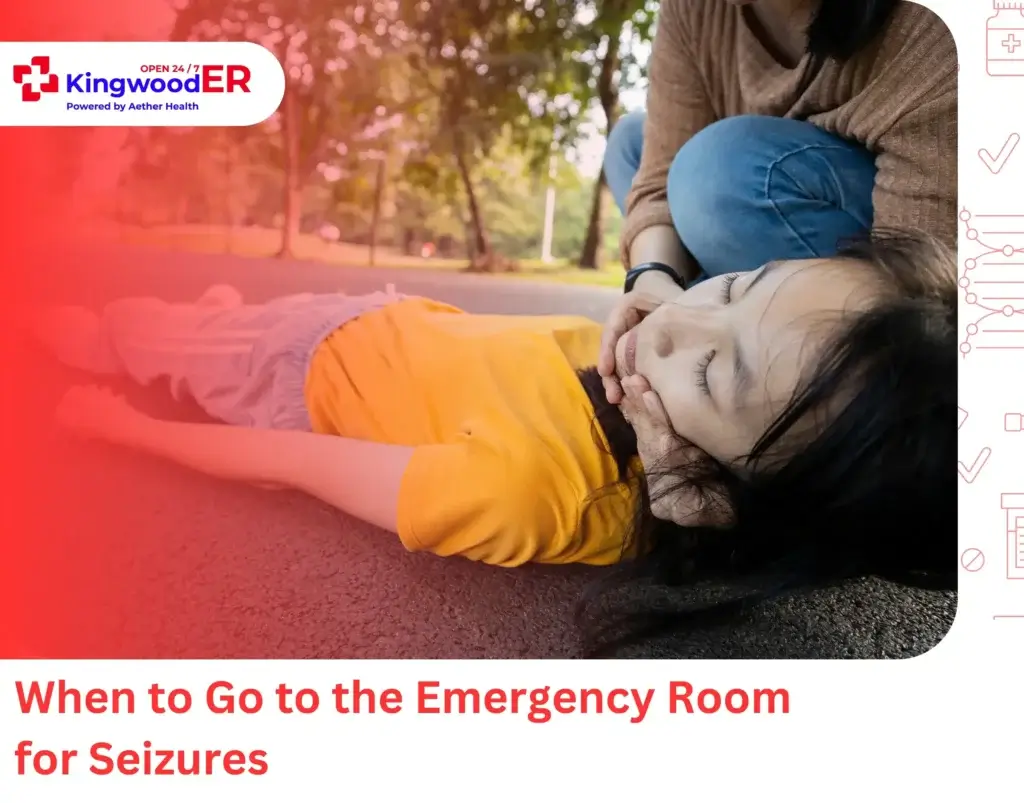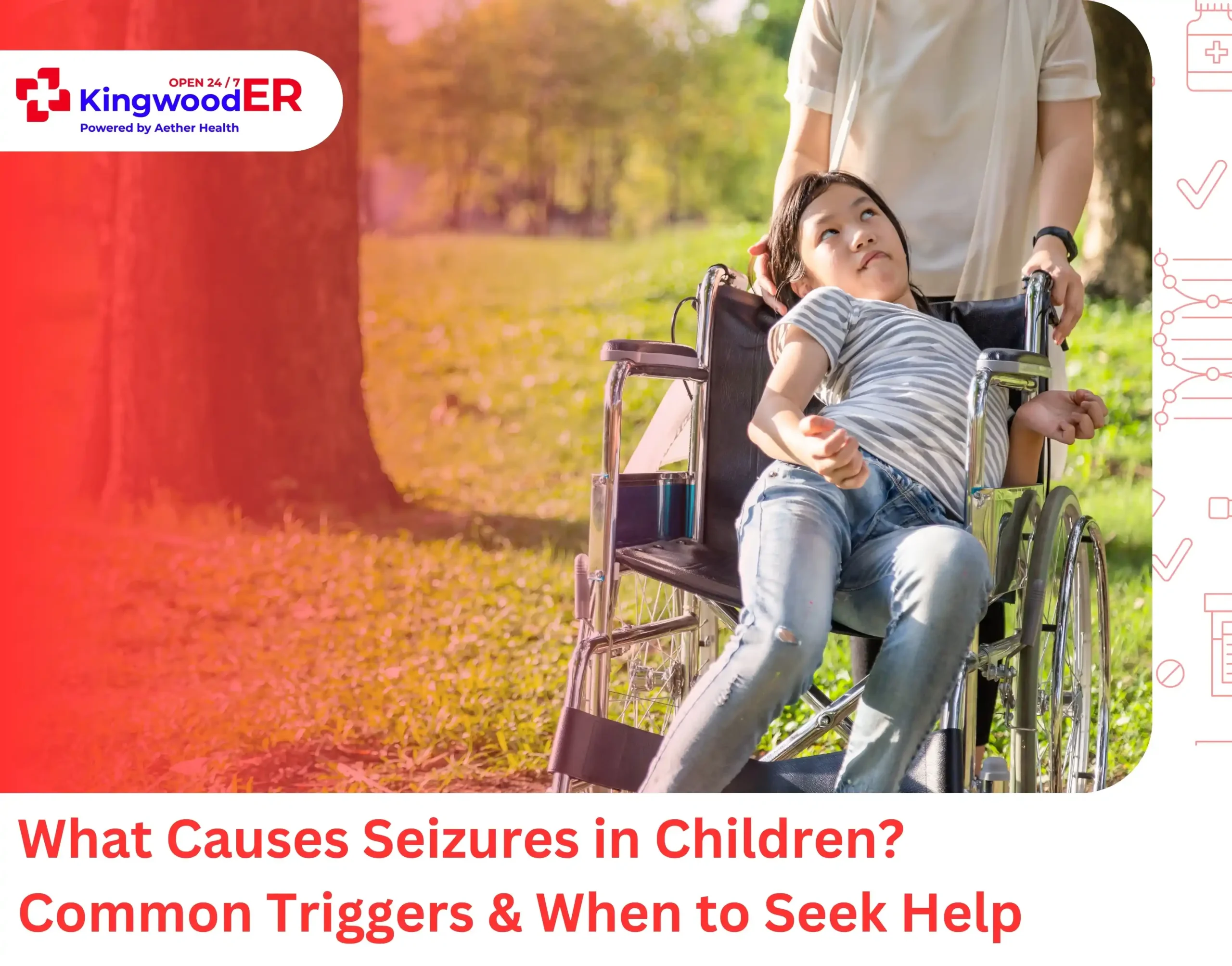Did you know that about 1 in 20 children experience a seizure at some point during childhood1? Most parents panic when they suddenly see their child moving or jerking in a strange way.
But seizures aren’t always a sign of something serious. Understanding what causes seizures in children can help parents stay calm and present at that moment.Even when there’s no serious underlying cause, it’s wise to seek immediate treatment to prevent recurrent seizures, later development of epilepsy, or learning difficulties. Let’s break down the common causes of seizures in children, warning signs, and when it’s time to seek emergency care for seizures.
What Is a Seizure?
A seizure occurs when there is abnormal electrical activity in the brain. This sudden burst of activity can cause changes in movement, behavior, feelings, and levels of consciousness. Seizures can range from brief staring spells to full-body convulsions. They make up around 1% of all pediatric emergency visits.2
Types of Seizures in Children
Seizures are classified as either generalized or focal, depending on where they originate in the brain. Understanding the types help you identify them:
- Generalized seizures: Affect both sides of the brain; may involve convulsions, muscle stiffening, or loss of consciousness.
- Focal seizures: Start in one part of the brain; may involve staring, confusion, or localized twitching.
What Causes Seizures in Children: 8 Common Causes

Several known causes and risk factors contribute to seizures in children.
1. Febrile Seizures
These seizures are triggered by a sudden spike in body temperature, usually from a viral or bacterial infection. They are most common in children between 6 months and 5 years of age.
Key signs of febrile seizures: Convulsions that last a few seconds to minutes, often during a high fever.
Note: Febrile seizures, while scary, are generally harmless and do not mean the child has epilepsy.
2. Epilepsy
Epilepsy is a neurological condition where a child has two or more unprovoked seizures. It may be caused by genetic factors, structural brain abnormalities, or unknown reasons.
Key signs of epilepsy: Recurrent seizures of varying types (e.g., focal, generalized) without an obvious fever or infection.
3. Head Injuries
A traumatic brain injury like a fall, car accident, or sports injury can disrupt brain function and lead to seizures, either immediately or later. Seizures that happen shortly after a head injury are called post-traumatic seizures.
Note: Always seek medical attention after a head injury, especially if seizures follow.
4. Infections
Certain infections can irritate the brain or its protective tissues, leading to seizures. Serious infections that can cause seizures in children include:
- Meningitis: An infection of the membranes covering the brain and spinal cord.
- Encephalitis: Inflammation of the brain, often caused by a virus.
- Sepsis: A body-wide response to infection that can affect the brain.
Warning signs: Fever, stiff neck, vomiting, confusion, or lethargy alongside a seizure.
5. Genetic or Metabolic Disorders
Some inherited conditions, such as metabolic disorders or chromosomal abnormalities, can disrupt the brain’s electrical activity and trigger seizures.
Example: Certain enzyme deficiencies or rare syndromes may affect how a child’s body processes chemicals, leading to seizures.
6. Brain Tumors or Structural Abnormalities
Although rare, abnormal growths or developmental issues in the brain can also cause seizures.
Key signs: Seizures that increase in frequency, are focal (starting in one area), or don’t respond to usual treatment.
7. Sleep Deprivation
Lack of adequate sleep can lower the seizure threshold in some children, particularly those with epilepsy.
Advice: Ensure regular sleep patterns and a calming bedtime routine.
8. Exposure to Toxins or Drugs
Ingesting certain household toxins, medications, or drugs can cause seizures in children.
Tip: Keep medications and cleaning products out of reach of children to prevent accidental poisoning. Seek emergency help if ingestion is suspected.
What to Do if a Child Has a Seizure

Now that you know what causes seizures in children, here’s what you should do if your child has a seizure:
- Stay calm and gently place the child on a safe, flat surface.
- Turn them on their side to keep airways clear.
- Time the seizure. If it lasts more than 5 minutes, call emergency services.
- After the seizure, comfort the child and seek medical attention for evaluation.
What Not to Do When Your Child Has a Seizure
- Don’t panic: Staying calm helps you think clearly and support your child better.
- Don’t try to hold them down: Trying to stop the movements can lead to injury. Let the seizure run its course.
- Don’t put anything in their mouth: It can cause choking or damage their teeth or jaw.
- Don’t try to wake them up if they’re unconscious afterward: It’s normal for children to be sleepy or confused after a seizure.
- Don’t delay getting medical help if it’s their first seizure, lasts more than 5 minutes, or looks different than usual.
When to Go to the Emergency Room for Seizures

You may know what causes seizures in children, but you don’t know how severe they can be. See a doctor immediately if:
- The seizure lasts more than 5 minutes
- It’s the child’s first seizure
- The child has trouble breathing afterward
- There are signs of infection (e.g., fever, stiff neck, rash)
- Seizures happen frequently or without clear triggers
Final Thoughts
Knowing what causes seizures in children helps reduce panic and promotes faster, more effective care. While many childhood seizures, like febrile seizures, are harmless and don’t cause long-term effects, others may signal a chronic condition like epilepsy or a more serious illness.
So, always reach your nearest emergency room whenever your child has a seizure. Aether Health ER is open 24/7 with on-site labs to quickly find out what’s causing your child’s seizure. Keep your child safe with a timely diagnosis and expert care.
FAQs:
1. What are the most common causes of seizures in children?
The most common causes include high fever (febrile seizures), epilepsy, head injury, infections like meningitis, and genetic conditions.
2. Are febrile seizures dangerous?
Febrile seizures can be frightening but are generally not harmful or indicative of long-term health issues. However, they should still be evaluated by a doctor.
3. When should I take my child to the hospital for a seizure?
Seek immediate medical help if the seizure lasts longer than 5 minutes, occurs without a fever, repeats in a short time, or if your child has trouble breathing or doesn’t regain consciousness promptly.
4. Can seizures in children be outgrown?
Yes, many children outgrow febrile seizures and some forms of childhood epilepsy as they age.
5. Are all seizures noticeable?
No. Some seizures, like absence seizures, may appear as brief staring spells and can be mistaken for daydreaming or inattentiveness.
6. Can diet affect seizures in children?
In some cases, yes. A ketogenic diet may be recommended for children with hard-to-control epilepsy, but always consult a healthcare professional.
7. How are seizures diagnosed in children?
Diagnosis often involves a detailed medical history, EEG (electroencephalogram), blood tests, and brain imaging like MRI or CT scans.
8. Can a child with seizures lead a normal life?
Yes, with proper diagnosis and management, many children with seizures can live active, healthy lives.



